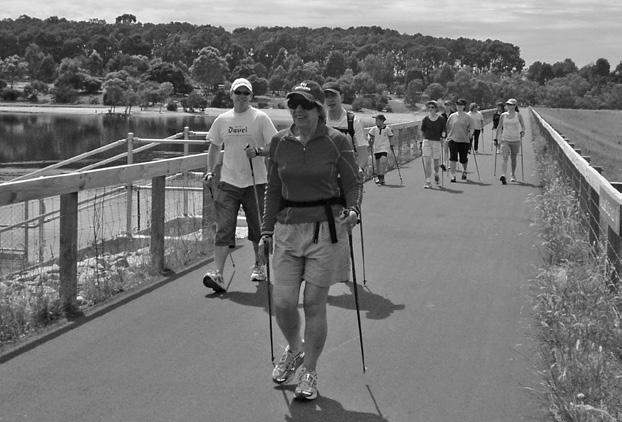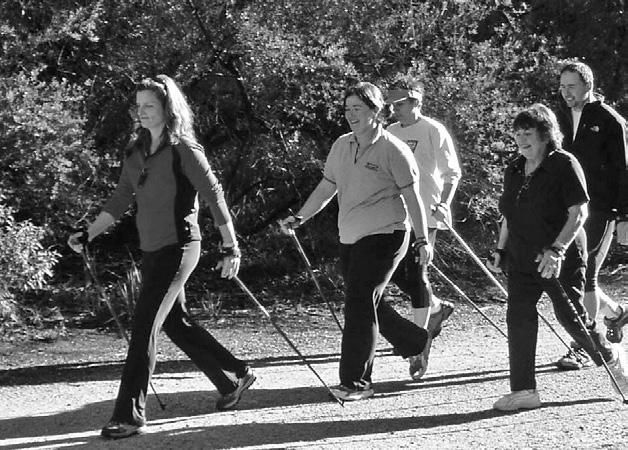
6 minute read
NORDIC WALKING
Executive Matters
Kay Grzadka
Annual Conference, Canberra
The Orienteering Australia Annual Conference was held in Canberra on the first weekend of December 2007. On the Friday before the Conference the Board of Orienteering Australia met specifically to review and revise the Operational Manual. Amendments requiring Council approval were presented to the Conference or will be presented to the Annual General Meeting in March 2008, after which the a completely revised version of the Operational Manual will be posted at http:// www.orienteering.asn.au/ administration/op_manual/ . Some of the proposals discussed and agreed by the OA Council at the Annual Conference were: • Revision of the Member
Protection Policy in accordance with the Australian
Sports Commission template #; • Revision of the Conflict (Dispute) Resolution policy and transfer from the
Constitution to the Operational
Manual #; • Inclusion in the Operational
Manual of a policy for Appeals for other than misconduct; • Inclusion in the Operational
Manual of the paper outlining the distribution of functions between Orienteering Australia and States #; • The due date for State
Registration Fees to change from 30 June to 30 April; • Amendments to clauses 13 and 15 of the Orienteering
Australia Constitution to facilitate the use of electronic banking and to reflect the move away from a permember levy on States to other forms of OA fees #; • Contribution by OA to the costs incurred by the Vice President, IOF, and funding of another person to attend
International Orienteering
Federation Council meetings; • Continued support for
OA representation in the
International Orienteering
Federation; • Simplification of the current rule regarding Start Draws; • Change to the current
Embargo rule to allow for events being held in public locations; • Support for Australian representation in the 2010
International Schools
Championships; • Staging of two test matches per calendar year between
Australia and New Zealand for elite senior teams; • Amendment to the rules for
Australian Teams to strengthen wording and accountability; • Endorsement of guidelines for the 2008 National Orienteering
League; • Endorsement of the Junior
Selection Panel structure as a panel of three but with one of the coaches being a member of the panel; • Amendment to the age guidelines for the Junior
Development Squad to make them clearer and allow for the selection of older juniors; • Change to Junior Selection rules to allow performances in specific overseas events to count for selection purposes; • Support for the inclusion of suitably qualified juniors in the
Senior Team for the Mountain
Bike World Orienteering
Championships; and • Full representation on the
Orienteering Australia Council for MTBO #. Two workshops were held during the Conference: the first dealing with the rotation of national events and from which a modified calendar of events was produced; and the second looked at increasing the participation of sub-juniors in Orienteering. The complete minutes of the Annual Conference will be posted at http:// www.orienteering.asn.au/ administration/minutes/ # Effective after the 2008 Annual General Meeting.
NORDIC WALKING ORIENTEERING
The Power of Walking
POWER WALKING has been the major growth category for Orienteering in the past five years or so. This summer, after the first 40 events of Melbourne’s four park & street Summer Series programs, some 35% of participation has been in the Power Walking categories. Power Walking Orienteering attracts people who want to get out and exercise both their minds and their bodies but who would baulk at the thought of having to run. If you have a competitive streak and Orienteering sounds great but you don’t want to run, the Power Walking category is the one for you. A logical extension to the idea of competitive walking is Nordic Walking Orienteering, particularly in hilly or rough terrain. Nordic Walking poles help to exercise much more of the upper body than just plain

walking does. The thermogram illustrations here show that use of Nordic Walking poles greatly increases blood flow in the upper body (the light sections are regions of higher body temperature). Use of the poles in rough terrain gives greater stability to those recovering from injury (see box) and those with chronic lower body problems. The disadvantage for orienteers using Nordic Walking poles is in carrying the map. Step forward the instant solution to that problem in the map holders used by Ski Orienteers. At Swiss O Week the use of Nordic Walking poles and the Ski-O map holder was demonstrated each evening at the prize ceremonies in Zermatt (see photo). Closer to home in Victoria, Tuckonie orienteer Jan Thomas uses the poles at park & street events to give her more stability in rough terrain. Nordic Walking Orienteering could be just the catalyst needed to boost participation in the Bush-O format of our sport. Participation in Bush-O has been largely static for many years and the format needs something new to attract more non-elite participants. Use of Nordic Walking poles in the bush will give greater stability to people who might be unsure of themselves in rough and steep terrain, allowing those who might otherwise hesitate to try Bush-O to get out and give it a go.



Body thermograms show how Nordic Walking increases blood circulation. (Courtesy Pole Attraction)
Nordic Walking poles increase upper body exercise during walking. Photo courtesy Pole Attraction. Left: Demonstration of Nordic Walking Orienteering at Swiss O Week in Zermatt. Right: Tuckonie orienteer Jan Thomas uses Nordic Walking poles in Melbourne’s park & street events. Photos: Mike Hubbert

Pole Attraction conducts regular Nordic Walking classes in Melbourne’s parks. Photo courtesy Pole Attraction
The Lisa Lampe story
Lisa Lampe (Uringa, NSW) competed at the Swiss O Week in the high Alps under the Matterhorn. Down at Zermatt in the evenings she was impressed by the demonstrations of Nordic Walking Orienteering and bought herself a set of poles. On the very last day of Swiss O Week Lisa put her foot down a marmot hole (see The Australian Orienteer, October’06, p36) severely injuring her ankle. The ankle was placed in a brace and Lisa rested for a week in Zurich. Then she went to Arhus in Denmark where she was entered in the public races associated with WOC 2006. Being a competitive soul Lisa lamented that she would have to miss all her events. We suggested that with her injured ankle in a very good protective brace, one good leg and two Nordic Walking poles, she had three points of balance. Why not try walking slowly to the start to see how things went. At the very least she could collect her map and walk back. That day she got two easy controls. The ankle was a bit sore overnight but Lisa decided to try again next day, and the day after that. By the 6th and final day Lisa got all her controls except one that was down across a steep creek crossing which would have been silly to attempt. Apart from enjoying her time out in the Danish forest, the spin-off for Lisa was that, with her injured ankle securely braced but the rest of her body getting some good exercise, the increased blood flow was repairing her injury faster than if she had just sat in the arena with her foot up watching people coming in from the forest.







